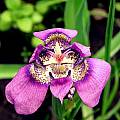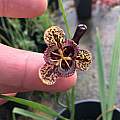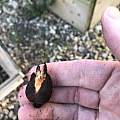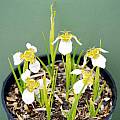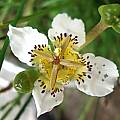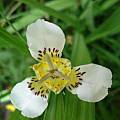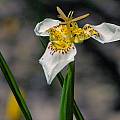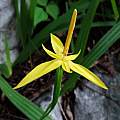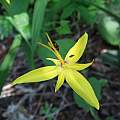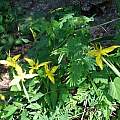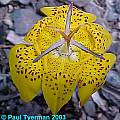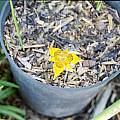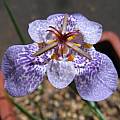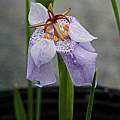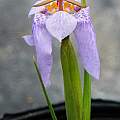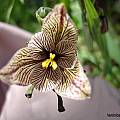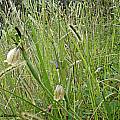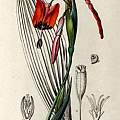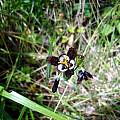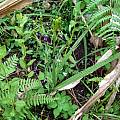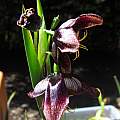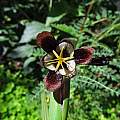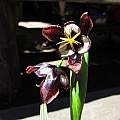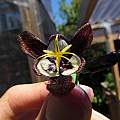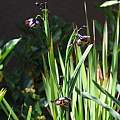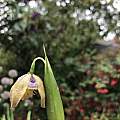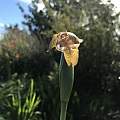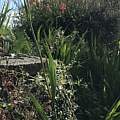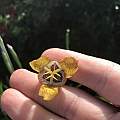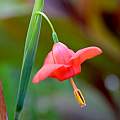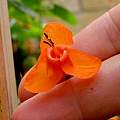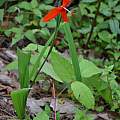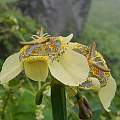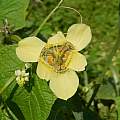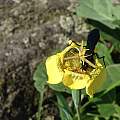Tigridia is a genus of about 30 species mainly from Mexico and Guatemala but extends south to Chile. They produce a succession of short lived flowers which are usually in bright colours. The rootstock is a tunicated bulb, found from 3 to 15 cm deep in the wild. Leaves are pleated in a broad fan. The best known species is Tigridia pavonia whose flowers are 10-15 cm (4 -6 inches) across in red, orange, yellow or white variously blotched in the centre. They commence growth in spring and generally die back during autumn. This genus was the subject of the topic of the week September 2003. An introduction was furnished by Alberto Castillo. In their 2008 book, The Iris Family: Natural History and Classification, Peter Goldblatt and John Manning included the four species of Rigidella that differed only in having a minute outer segment. They viewed this as merely an adaptation for hummingbird pollination. Also included were one of the species in the genus Colima and the genus Sessilanthera.
This page contains Tigridia A - L
Tigridia index – Tigridia M - Z
Tigridia augusta Drapiez is a diminutive, spring-flowering species found in the central Mexican altiplano. It grows in open fields and pastures at relatively high elevations (2350-2500 meters above sea level). The flowers appear in May at the onset of the rainy season before the foliage has fully developed. In its native habitat it flowers at the same time as Tigridia mexicana. This species has been collected throughout the Tranverse Volcanic Belt from Jalisco to Puebla. This plant was previously known as Tigridia violacea Schiede ex Schltdl. Height range: 45-60 cm. Photo by Dennis Szeszko.
Tigridia bicolor Molseed is native to Oaxaca State, Mexico. Photos by Michael Hughes, who comments: "Seed sown in January 2018, flowered in early October 2019. Grown in a mix of molar clay cat litter and compost, no dry period and kept just above zero. Location is coastal North West Wales so usually damp mild conditions. Growing to around 20 cm tall, 3 leaves, dark green, rigid, thin 5 mm up to 10 mm wide. Stem thin round and about 3 mm wide. Smell of flowers musky / fetid but not unpleasant. Flowers to 3.5 cm wide, straw yellow backing with burgundy spotting. Side facing bowl shaped, 4 to 6 flowers per each raceme. Bulbs 2 cm wide and 2.5 cm long."
Tigridia chiapensis Molseed ex Cruden is native to wet meadows in Mexico and is dormant in winter and flowers in summer. Height range: to about 40 cm. Grown and photographed by Rob Hamilton in the first photo, it is shown growing in Chiapas in the next two photos taken by Alfredo Gómez López. One of them shows a plant with an extra stem, petal, etc. The last photo was taken by Mary Sue Ittner.
Tigridia convoluta (Ravenna) Goldblatt (syn. Colima convoluta (Ravenna) Aarón Rodr. & Ortiz-Cat.) is a yellow species from western Mexico with unequal tepals. Height range: 30-45 cm. Photos from iNaturalist were taken by Jennie Lovell and shared under a CC BY-NC license.
Tigridia dugesii S.Watson is native to a semiarid area of Mexico. Height: 6 cm. The first photo is a close-up taken by Paul Tyerman. The second is a photo taken by Rob Hamilton. The last two were photographed by Mary Sue Ittner at Telos Rare Bulbs.
Tigridia durangense Molseed ex Cruden, a summer grower from Mexico, is not an easy species to grow in a warm, humid climate, but the very striking flowers make it worth the effort. The flower diameter is approximately 40 mm. Note the yellow, anther-like processes on the inner tepals - an interesting case of floral deception. The first photo shows a flower of plants grown and photographed by Rogan Roth. The next two were photographed at Telos Rare Bulbs by Mary Sue Ittner.
Tigridia ehrenbergii (Schltdl.) Molseed is a tall species (80 cm) that grows in a dry tropical climate in Mexico in partially shaded places between 900 and 1600 meters. It's a very variable plant that is similar to Tigridia hallbergii and Tigridia vanhouttei ssp. roldanii except that it has flowers with an unpleasant smell.
Tigridia ehrenbergii subsp. ehrenbergii from Puebla, Mexico. Photos by Verónica Chavez.
Tigridia ehrenbergii subsp. flavigera Cruden is the other subspecies.
Tigridia flammea (Lindl.) Ravenna (syn. Rigidella flammea Lindl. ) is native to the pine woods of Mexico where it grows at 3000 meters. It has bright scarlet outer segments and pendulous flowers. Height range: to about 1 m. The picture shows a scan of the illustration from "Edward's Botancal Register" vol 26 (1840), under the old name of Rigidella flammea.
Tigridia hallbergii Molseed is distributed in Oaxaca and Chiapas, Mexico and in Guatemala where it grows in open pine forest in moist soils in partial shade at 900-3000 m. The plants are 30-60 cm high. This species can be grown as Tigridia pavonia. It requires good and constant watering in summer. It is beneficial to fertilize when the plant just comes out of dormancy. In dry-summer climates, the plants are very susceptible to mites that hide in between the folds of the leaves. In winter, allow the bulbs to dry out. In the San Francisco Bay Area, this plant can be grown outdoors but it should be watered and allow to break dormancy indoors where it is warmer.
The photos below were taken by Alfredo Gómez and contributed by Rafa Díez Dominguez, from San Cristobal de las Casas, Chiapas, Mexico.
Tigridia hallbergii subsp. hallbergii is found in western Guerrero, Oaxaca, Chiapas, and Guatemala. The flowers are dull maroon-purple. The photos below were taken by Nhu Nguyen in cultivation. It took 3 years for this bulb to bloom from seeds.
Tigridia hallbergii subsp. lloydii Cruden is known only from the type locality in Guerrero, Mexico. The plants are more robust than subsp. hallbergii. There are no basal leaves, and the flowers are yellow with maroon spotting. Pictures taken by Michael Hughes from seed sown January 2018, flowering in July 2020. Location is North West Wales, maritime conditions. In early growth the first leaf is basal but as the stem extends grows clear of the soil. Tall plant to 80 cm racemes in each of the leaf axils.
Tigridia immaculata (Herb.) Ravenna (syn. Rigidella immaculata Herb.) from high altitude forest areas of Guatemala and southern Mexico has bright orange to scarlet, pendulous flowers which seem to be self-sterile. The whole plant is rather slender and delicate. The buds completely leave the spathes the evening before flowering (pic 2), and the flowers open up quite early in the morning. The pictures by Martin Bohnet show a plant obtained from Crûg farm.
Tigridia inusitata (Cruden) Ravenna (syn. Rigidella inusitata Cruden) is from moist, rocky areas in the cloud forests of Mexico. The orange-red flowers have reflexed outer segments. Height range: 45-60 cm. Photo from iNaturalist was taken by Elsa Cabrerax in February and shared under a CC BY-NC license.
Tigridia lutea Link, Klotzsch & Otto is native to the "lomas" of Lima and Ancash, an ecosystem that is characterized by being dry for 6 months (summer), and wet & covered by vegetation the other 6 (winter). The leaves start growing in June, the flowers appear from August to October, and seeds can be collected from October to November. Floral visitors include flies, bees and Pesis wasps (also called Tarantula Hawks). This species can be propagated by bulblets and seeds. They can be expected to produce flowers a year and a half after the seeds are sown. Height range: 20-30 cm.
All South American species are proposed to be transferred to Mastigostyla, as phylogenetic studies indicated them to be closer to that genus. Photos from Norton Cuba Melly.
Tigridia index – Tigridia M - Z
